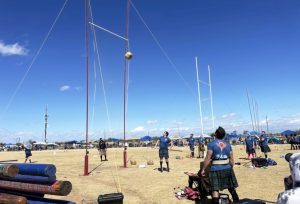- Slug: Sports-Phoenix Scottish Games 800 words.
- 3 photos available
By Alyssa Polc
Cronkite News
GILBERT – You didn’t have to be Scottish to have an experience that was “pure dead brilliant,” as the revelers might say, at the recent Phoenix Scottish Games.
Everything from decadent meat pies, caramel apple nachos and sausages to exhilarating games such as hammer throwing, caber tossing and weight toss for distance were accessible to visitors at Gilbert Regional Park during the 57th edition of the event. People frolicked around in kilts of all colors, checked out merchandise and food stands and listened to the multiple bagpiper groups playing while waiting intently each day for the games to begin.
On the first night, there was an amphitheater concert called “The Twilight Tattoo.” Attendees listened to the Scottish bagpipe sounds of The Arizona Band of the U.S. Coast Guard Auxiliary, The Los Angeles Fifes & Drums, The 103rd Arizona Regimental Band, and The Mesa Caledonian Pipe Band. Highland dancers accompanied the music.
The highlights of the second and third days were a Highland Dance competition, men’s and women’s heavy athletic events and the Desert Southwest Pipe Band championships. In the dance competition, the prizes on offer included a chance to attend the nationals.
According to the Caledonian Society of Arizona, which organizes the Phoenix Scottish Games, the original Scottish Society of Arizona was formed on September 26, 1953. The first Highland Games took place in 1964 and were arranged by members who played in the Phoenix Scottish Pipe Band.
“It’s a way to help understand and spread Scottish heritage around,” Steve Mills of Clan MacKinnon said. “You meet so many wonderful people each year. My great-great- grandmother, Catherine, migrated from the Isle of Skye and helped bring awareness to the Games and now, here we are.”
The Phoenix Scottish Games featured roughly 30 different clans, each of which had a booth for visitors to check out and learn more about its origins and behold the intricate designs of its medallions. There was also a genealogy area for those who wanted to know more about their Scottish lineage.
It’s hard to talk about Scottish clans, culture and heritage without bringing up their world-famous attire, the kilt.
Authentic kilts are “made of a woolen cloth in a tartan pattern,” according to Lochcarron of Scotland, the world’s leading manufacturer of tartan. They were the Games’ official uniform, and visitors had the chance to buy their own.
“If you are Scottish, you typically go with the colors of your clan,” Phoenix Scottish Games athlete Bill Doe said. “If you’re not Scottish, you get, basically, whatever color you like.”
The most anticipated events of the weekend were the men’s and women’s heavy athletic games. Players were separated into groups based on age, weight, height, and experience level. The games included: Weight Over Bar, Weight Toss for Distance, Hammer Throw, Braemar Stone Put, Caber Toss, and Sheaf Toss. During each event, groups attempted to accumulate as many points as they could. After each group was done, the points were calculated and the awards were handed out.
A Weight for Distance thrower in a purple-and-black kilt who identified herself as Rachael, said, “We’ve been using Esteban Park the last couple weeks. It’s nice to finally have a field to finally practice and play on.”
The participants ranged from pros who have played for years to novices. Typically, each competitor pays a fee to play, but no Scottish blood is required.
“I don’t have any Scottish in me,” Adam Jones, a first-time competitor. “I’d been to the festival several times, and in 2020 I came and was like ‘I could do that’. Someone I knew hooked me up and signed me up.”
One of the most popular games appeared to be the caber toss. A caber is a pole, rafter or tree that is picked up and carried vertically by an athlete long enough to get a solid grip and then tossed into the air, lumberjack-like. The objective is for the pole, rafter or tree to flip end-over-end and fall away from the athlete.
“I like the caper,” Jones said. “Everyone is kind of equal. As long as you can pick it up, it’s all about technique.”
The hammer toss was also popular. The “hammer” used looked similar to the original Olympic hammer except instead of a wooden handle it had weights attached to PVC pipes. Players use a tacky substance to improve their grips and bladed hammer boots that dig into the ground to improve their stability and enhance their control.
“Most people buy the boots with the blade on them,” Doe said, “but some of the guys you see here will use old lawn mower blades, shave them down and attach them to the front of the boots.”
Asked about the throwing technique of the heavy 22-pound weight or the lighter 16-pound one, Doe said, “Get as much speed as you can. There comes a point of diminishing returns. Some do one [swing] and go, two and go. Very rarely, people do three swings.”
For more stories from Cronkite News, visit cronkitenews.azpbs.org.


